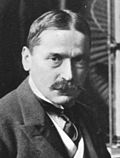Kingdom of Yugoslavia
The Kingdom of Serbs, Croats, and Slovenes later known as the Kingdom of Yugoslavia was a state in Southeast and Central Europe which existed from 1918 until 1941.
Yugoslavia Југославија Jugoslavija | |
|---|---|
| 1918–1941 | |
| Anthem: | |
 The Kingdom of Yugoslavia | |
| Capital and largest city | Belgrade 44°49′N 20°27′E / 44.817°N 20.450°ECoordinates: 44°49′N 20°27′E / 44.817°N 20.450°E |
| Official languages | Serbo-Croatian Macedonian Slovene |
| Demonym(s) | Yugoslav |
| Government | Monarchy
Details
|
| Historical era | 20th century |
• | 1 December 1918 |
| 6 April 1941 | |
| Currency | Yugoslav dinar |
| Calling code | 38 |
| Today part of | |
History
Background
In 1903, King Alexander I of Serbia was murdered and replaced with Peter I of Serbia. After this, Serbia became more nationalist. Tensions with Austria-Hungary heightened when it conquered Bosnia in 1908. During this period Serbia managed to extend its borders and reconquer Kosovo and North Macedonia from the Ottoman Empire. Many Serbian nationalists wanted to create a unified state for the Slavs of the Balkans. Covert gangs attempted to assassinate Austro-Hungarian officials, like the Bosnian governor. In June 1914, a Bosnian Serb called Gavrilo Princip killed Austrian Archduke Franz Ferdinand in Sarajevo, Bosnia. This event eventually led to World War I.[1]
Creation
Yugoslavia came into existence in 1918 after World War I. Most of its northern territories were given to it from Austria-Hungary when it collapsed during the war. Its territories were reconquered by Serbia from the Ottoman Empire during the Balkan Wars (1912–13). The reigning king in Serbia became the king of all Yugoslavia.
For ten years, it was known as the Kingdom of Serbs, Croats and Slovenes.[2] It began using the name 'Yugoslavia' in 1929. The name 'Yugoslavia' is Serbo-Croatian for 'Land of the Southern Slavs'. The Kingdom was invaded by the Axis Powers in 1941 and quickly fell during World War II. A Federal Democratic Republic was declared in 1943 with the King's approval, but the monarchy was abolished shortly after.[3]
Kingdom Of Yugoslavia Media
Celebrations in Zagreb during the formation of the National Council of the State of Slovenes, Croats and Serbs, October 1918
Serbian Army in Zagreb's Ban Jelačić Square in 1918
Delegation of the National Council of the State of Slovenes, Croats and Serbs led by Ante Pavelić reading the address in front of regent Alexander, 1 December 1918
Mihajlo Pupin, Serbian physicist and physical chemist. He influenced the final decisions of the Paris Peace Conference when the borders of the Kingdom were drawn.
Between 1918 and 1926, Nikola Pašić held the position of Prime Minister of Yugoslavia three times.
References
- ↑ Rujević, Nemanja (28 July 2014). "Serbia, WWI, and the question of guilt". Deustche Welle (on the Web). https://www.dw.com/en/serbia-wwi-and-the-question-of-guilt/a-17550497. Retrieved 23 December 2019.
- ↑ "Kingdom of Serbs, Croats, and Slovenes - Historical kingdom, Balkans [1918-1929]". Encyclopædia Britannica. Encyclopædia Britannica. January 25, 2011.
- ↑ "Yugoslavia - former federated nation (1929-2003)". Encyclopædia Britannica. Encyclopædia Britannica. 22 February 2019.








